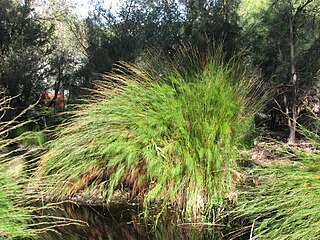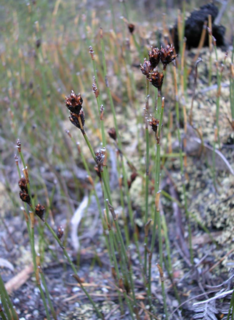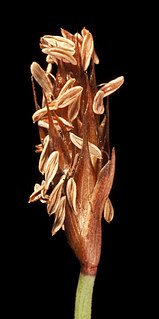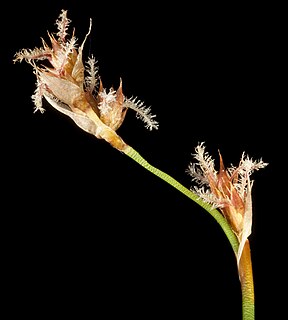
The Restionaceae, also called restiads and restios, are a family of flowering plants native to the Southern Hemisphere; they vary from a few centimeters to 3 meters in height. Following the APG IV (2016): the family now includes the former families Anarthriaceae, Centrolepidaceae and Lyginiaceae, and as such includes 51 genera with 572 known species. Based on evidence from fossil pollens, the Restionaceae likely originated more than 65 million years ago during the Late Cretaceous period, when the southern continents were still part of Gondwana.

The Grevilleoideae are a subfamily of the flowering plant family Proteaceae. Mainly restricted to the Southern Hemisphere, it contains around 46 genera and about 950 species. Genera include Banksia, Grevillea, and Macadamia.

Apodasmia similis, also known as oioi or jointed wire rush, is a plant that is endemic to New Zealand. It is a coastal plant but is also found around peat bogs and hot springs. It flowers from October to December and bears fruit from December to March.

Apodasmia is a group of plants in the Restionaceae described as a genus in 1998. It is native to Australia, New Zealand, and Chile.

Empodisma minus, commonly known as (lesser) wire rush or spreading rope-rush, is a perennial evergreen belonging to the southern-hemisphere family of monocotyledons called the Restionaceae. The Latin name Empodisma minus translates to “tangle-foot” “small”. E. minus is found from Queensland to South Australia, Tasmania and throughout New Zealand south of 38 ° latitude, or the central north island. Its current conservation status is “Least concerned”. In 2012 the new species Empodisma robustum was described in New Zealand, with what was previously described as E. minus from the lowland raised bogs of Waikato and Northland now being re-classified as E. robustum. E. minus remains an important peatformer in the south of New Zealand and in high altitude peatlands.

Alexgeorgea is a genus of three plant species found in Western Australia belonging to the family Restionaceae named in honour of the botanist Alex George in 1976. The flowers of the female and large nut-like fruit are completely underground except for the stigmas, which extend out of the ground as 3 purple or red threads.

Agastachys odorata, commonly known as the white waratah, is the sole member of the genus Agastachys in the protea family. It is an evergreen shrub to small tree and is endemic to the heaths and button grass sedgelands of western Tasmania. It occurs most often in moist heath and scrub and occasionally in the alpine regions, but generally prefers well-drained but poor soils. It can grow in some rainforests where it forms a small tree but is normally a shrub in all other situations. The heaviest concentrations are along the island's south coast. Its leaves are dark green, hairless and almost succulent. Masses of white flowers are produced in erect spikes from the ends of the branches. Measuring 8 to 12 cm high, they appear in January and February.

Baloskion tetraphyllum is a rush-like plant in the family Restionaceae. Common names include tassel rope-rush, plume rush and Australian reed.
Calorophus is a group of plants in the Restionaceae described as a genus in 1806. The entire genus is endemic to Australia, found in the States of Victoria and Tasmania.
Dapsilanthus is a genus of plants described as a genus in 1998.

Chordifex is a genus of plants in the Restionaceae described as a genus in 1998. The entire genus is endemic to Australia.

Eurychorda is a group of plants in the Restionaceae described as a genus in 1998. There is only one known species, Eurychorda complanata, endemic to Australia.

Desmocladus flexuosus is a rhizatomous, sedge-like herb in the Restionaceae family, endemic to south-west Western Australia.
Baloskion longipes, common name dense cordrush, is a dioecious perennial herb in the Restionaceae family, found in southeastern New South Wales.

Chordifex hookeri is commonly known as woolly buttonrush or cord-rush. It is a rush species of the genus Chordifex in the family Restionaceae. The species is endemic to Tasmania.

Chaetanthus aristatus is a species of rush. It is found in Western Australia.

Chordifex laxus is a rush species of the genus Chordifex in the family Restionaceae. It is endemic to the south-west of Western Australia.

Chordifex microdon is a rush species of the genus Chordifex in the family Restionaceae, native to Western Australia.
Leptocarpus laxus is a rush species of the genus Leptocarpus in the family Restionaceae. It is endemic to the south-west of Western Australia.

Sporadanthus rivularis is a sedge-like herb in the Restionaceae family, native to Western Australia. It is a spreading perennial growing from rhizomes to heights of from 1 to 1.2 m, on black sands and clay along creek edges. It is a dioecious species.















